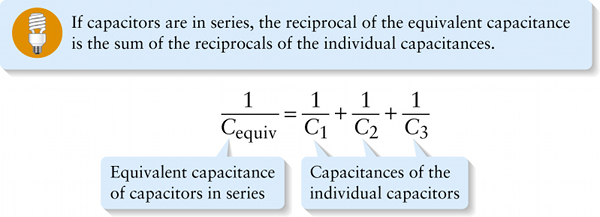Equivalent capacitance of capacitors in series (17-22)
Question 1 of 2
Question
Capacitances of the individual capacitors
{"title":"Equivalent capacitance of capacitors in series","description":"Wrong","type":"incorrect","color":"#99CCFF","code":"[{\"shape\":\"poly\",\"coords\":\"82,133\"},{\"shape\":\"rect\",\"coords\":\"10,16,12,16\"},{\"shape\":\"poly\",\"coords\":\"144,22\"},{\"shape\":\"rect\",\"coords\":\"3,41,24,67\"}]"} {"title":"Capacitances of the individual capacitors","description":"Correct!","type":"correct","color":"#ffcc00","code":"[{\"shape\":\"rect\",\"coords\":\"119,43,148,68\"},{\"shape\":\"rect\",\"coords\":\"191,42,220,68\"},{\"shape\":\"rect\",\"coords\":\"262,41,288,68\"}]"}Review
For the equivalent capacitor alone, of capacitance Cequiv, Equation 17-14 says that q=CequivV or V=q/Cequiv. If we compare this to Equation 17-21, we see that

If there are more than three capacitors in series, the same rule given in Equation 17-22 applies.
